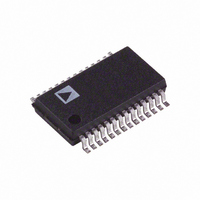AD7899ARS-2 Analog Devices Inc, AD7899ARS-2 Datasheet - Page 7

AD7899ARS-2
Manufacturer Part Number
AD7899ARS-2
Description
A/D Converter (A-D) IC
Manufacturer
Analog Devices Inc
Datasheet
1.AD7899ARSZ-1.pdf
(16 pages)
Specifications of AD7899ARS-2
No. Of Bits
14 Bit
Mounting Type
Surface Mount
No. Of Channels
1
Interface Type
Parallel
Package / Case
28-SSOP
Rohs Status
RoHS non-compliant
Number Of Bits
14
Sampling Rate (per Second)
400k
Data Interface
Parallel
Number Of Converters
1
Power Dissipation (max)
125mW
Voltage Supply Source
Single Supply
Operating Temperature
-40°C ~ 85°C
For Use With
EVAL-AD7899CBZ - BOARD EVAL FOR AD7899
Lead Free Status / RoHS Status
TERMINOLOGY
Signal to (Noise + Distortion) Ratio
This is the measured ratio of signal to (noise + distortion) at the
output of the A/D converter. The signal is the rms amplitude of
the fundamental. Noise is the rms sum of all nonfundamental
signals up to half the sampling frequency (f
The ratio is dependent upon the number of quantization levels
in the digitization process; the more levels, the smaller the quan-
tization noise. The theoretical signal to (noise + distortion) ratio
for an ideal N-bit converter with a sine wave input is given by:
Thus for a 14-bit converter, this is 86.04 dB.
Total Harmonic Distortion
Total harmonic distortion (THD) is the ratio of the rms sum of
harmonics to the fundamental. For the AD7899 it is defined
as: THD dB
where V
V
fifth harmonics.
Peak Harmonic or Spurious Noise
Peak harmonic or spurious noise is defined as the ratio of the
rms value of the next largest component in the ADC output
spectrum (up to f
fundamental. Normally, the value of this specification is deter-
mined by the largest harmonic in the spectrum, but for parts
where the harmonics are buried in the noise floor, it will be a
noise peak.
Intermodulation Distortion
With inputs consisting of sine waves at two frequencies, fa and
fb, any active device with nonlinearities will create distortion
products at sum and difference frequencies of mfa ± nfb where
m, n = 0, 1, 2, 3, etc. Intermodulation terms are those for which
neither m nor n are equal to zero. For example, the second order
terms include (fa + fb) and (fa – fb), while the third order terms
include (2fa + fb), (2fa – fb), (fa + 2fb) and (fa – 2fb).
The AD7899 is tested using two input frequencies. In this case, the
second and third order terms are of different significance. The
second order terms are usually distanced in frequency from the
original sine waves while the third order terms are usually at a
frequency close to the input frequencies. As a result, the second
4
, and V
Signal to (Noise + Distortion) = (6.02N + 1.76) dB
1
(
is the rms amplitude of the fundamental and V
5
are the rms amplitudes of the second through the
)
=
20
S
/2 and excluding dc) to the rms value of the
log
V
2
2
+
V
3
2
+
V
V
1
4
2
+
V
S
5
/2), excluding dc.
2
+
V
6
2
2
, V
3
,
and third order terms are specified separately. The calculation
of the intermodulation distortion is as per the THD speci-
fication where it is the ratio of the rms sum of the individual
distortion products to the rms amplitude of the fundamental
expressed in dBs.
Differential Nonlinearity
This is the difference between the measured and the ideal
1 LSB change between any two adjacent codes in the ADC.
Positive Gain Error (AD7899-1, AD7899-3)
This is the deviation of the last code transition (01 . . . 110 to
01 . . . 111) from the ideal 4 × V
± 10 V), 2 × V
– 3/2 LSB (AD7899 at ± 2.5 V range) after the Bipolar Offset
Error has been adjusted out.
Positive Gain Error (AD7899-2)
This is the deviation of the last code transition (11 . . . 110 to
11 . . . 111) from the ideal 2 × V
± 10 V), 2 × V
V
polar Offset Error has been adjusted out.
Unipolar Offset Error (AD7899-2)
This is the deviation of the first code transition (00 . . . 00 to
00 . . . 01) from the ideal AGND +1/2 LSB
Bipolar Zero Error (AD7899-1, AD7899-2)
This is the deviation of the midscale transition (all 0s to all 1s)
from the ideal AGND – 1/2 LSB.
Negative Gain Error (AD7899-1, AD7899-3)
This is the deviation of the first code transition (10 . . . 000 to
10 . . . 001) from the ideal –4 × V
± 10 V), –2 × V
+ 1/2 LSB (AD7899 at ± 2.5 V range) after Bipolar Zero Error
has been adjusted out.
Track/Hold Acquisition Time
Track/Hold acquisition time is the time required for the output
of the track/hold amplifier to reach its final value, within ± 1/2 LSB,
after the end of conversion (the point at which the track/hold
returns to track mode). It also applies to situations where there
is a step input change on the input voltage applied to the selected
V
for the duration of the track/hold acquisition time after the end
of conversion or after a step input change to V
starting another conversion, to ensure that the part operates to
specification.
REF
INA/VINB
– 3/2 LSB (AD7899 at 0 V to 2.5 V range) after the Uni-
input of the AD7899. It means that the user must wait
REF
REF
REF
– 3/2 LSB (AD7899 at 0 V to 5 V range) or
– 3/2 LSB (AD7899 at ± 5 V range) or V
+ 1/2 LSB (AD7899 at ± 5 V range) or –V
REF
REF
REF
– 3/2 LSB (AD7899 at
+ 1/2 LSB (AD7899 at
– 3/2 LSB (AD7899 at
INA
AD7899
/V
INB
before
REF
REF













